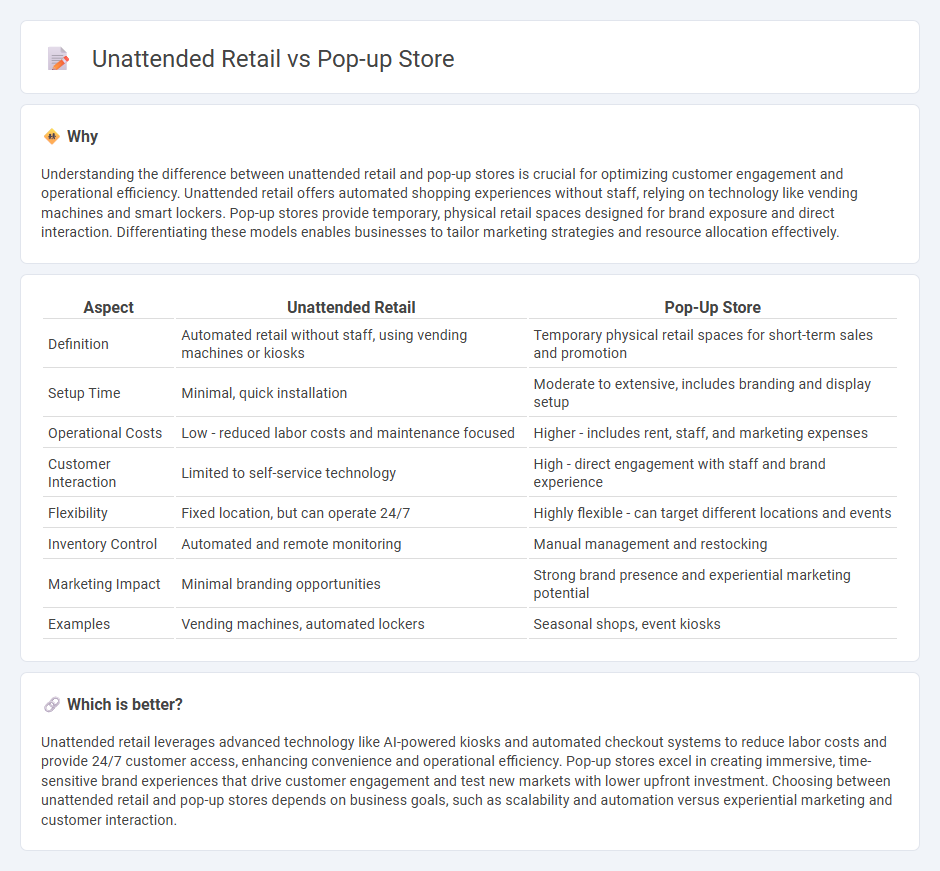
Unattended retail leverages automated technology such as smart vending machines and cashier-less kiosks to offer 24/7 shopping convenience without staff, optimizing operational efficiency and reducing labor costs. Pop-up stores create temporary physical retail spaces that engage customers through limited-time offers and immersive brand experiences, driving urgency and foot traffic. Explore the unique advantages of unattended retail and pop-up stores to innovate your retail strategy effectively.
Why it is important
Understanding the difference between unattended retail and pop-up stores is crucial for optimizing customer engagement and operational efficiency. Unattended retail offers automated shopping experiences without staff, relying on technology like vending machines and smart lockers. Pop-up stores provide temporary, physical retail spaces designed for brand exposure and direct interaction. Differentiating these models enables businesses to tailor marketing strategies and resource allocation effectively.
Comparison Table
| Aspect | Unattended Retail | Pop-Up Store |
|---|---|---|
| Definition | Automated retail without staff, using vending machines or kiosks | Temporary physical retail spaces for short-term sales and promotion |
| Setup Time | Minimal, quick installation | Moderate to extensive, includes branding and display setup |
| Operational Costs | Low - reduced labor costs and maintenance focused | Higher - includes rent, staff, and marketing expenses |
| Customer Interaction | Limited to self-service technology | High - direct engagement with staff and brand experience |
| Flexibility | Fixed location, but can operate 24/7 | Highly flexible - can target different locations and events |
| Inventory Control | Automated and remote monitoring | Manual management and restocking |
| Marketing Impact | Minimal branding opportunities | Strong brand presence and experiential marketing potential |
| Examples | Vending machines, automated lockers | Seasonal shops, event kiosks |
Which is better?
Unattended retail leverages advanced technology like AI-powered kiosks and automated checkout systems to reduce labor costs and provide 24/7 customer access, enhancing convenience and operational efficiency. Pop-up stores excel in creating immersive, time-sensitive brand experiences that drive customer engagement and test new markets with lower upfront investment. Choosing between unattended retail and pop-up stores depends on business goals, such as scalability and automation versus experiential marketing and customer interaction.
Connection
Unattended retail and pop-up stores intersect through their shared focus on creating flexible, technology-driven shopping experiences that operate without continuous staff presence. Retail analytics and IoT devices enable unattended retail in pop-up formats to track inventory, facilitate payments, and personalize customer interactions. This combination reduces operational costs while enhancing convenience and engagement in limited-time, high-impact retail environments.
Key Terms
**Pop-up Store:**
Pop-up stores create temporary physical retail spaces designed to generate buzz and drive immediate customer engagement through unique, time-limited experiences. These stores allow brands to test new markets, launch products, and gather direct consumer feedback without long-term commitments. Explore how pop-up stores can transform your retail strategy and boost brand visibility.
Temporary Location
Pop-up stores offer dynamic, temporary retail spaces that engage customers through face-to-face interactions and immersive brand experiences, often lasting from a few days to several weeks. Unattended retail focuses on automated, self-service formats like vending machines and smart lockers, allowing brands to maintain a temporary presence with minimal staff. Explore detailed comparisons and benefits of these temporary retail solutions to determine the best fit for your business needs.
Experiential Marketing
Pop-up stores create tangible, immersive brand experiences through temporary physical locations that engage customers directly, contrasting with unattended retail which relies on automated self-service kiosks or vending machines. Experiential marketing in pop-up shops leverages sensory stimuli, personalized interactions, and brand storytelling to foster emotional connections and memorable experiences. Explore how integrating these approaches enhances customer engagement and boosts brand loyalty.
Source and External Links
What is a pop-up shop? Benefits, types, and how to start - Printify - A pop-up shop is a temporary retail experience that opens for a short period to sell products or services, providing a cost-effective and flexible way for brands to create buzz, test new markets, and engage customers without the risks of a permanent store.
Introducing Printify Pop-Up Store - Printify offers an easy-to-use, free pop-up eCommerce store platform where users can sell custom merchandise with personalized options, handling print and shipping while maximizing profits without subscription fees.
What Is a Pop-Up Shop? Definition, Benefits and Costs (2025) - Shopify - A pop-up shop is a temporary retail event in a specific location, ideal for testing new products, responding to seasonal demand, and creating urgency, offering a physical retail presence without the long-term costs of a permanent storefront.
 dowidth.com
dowidth.com